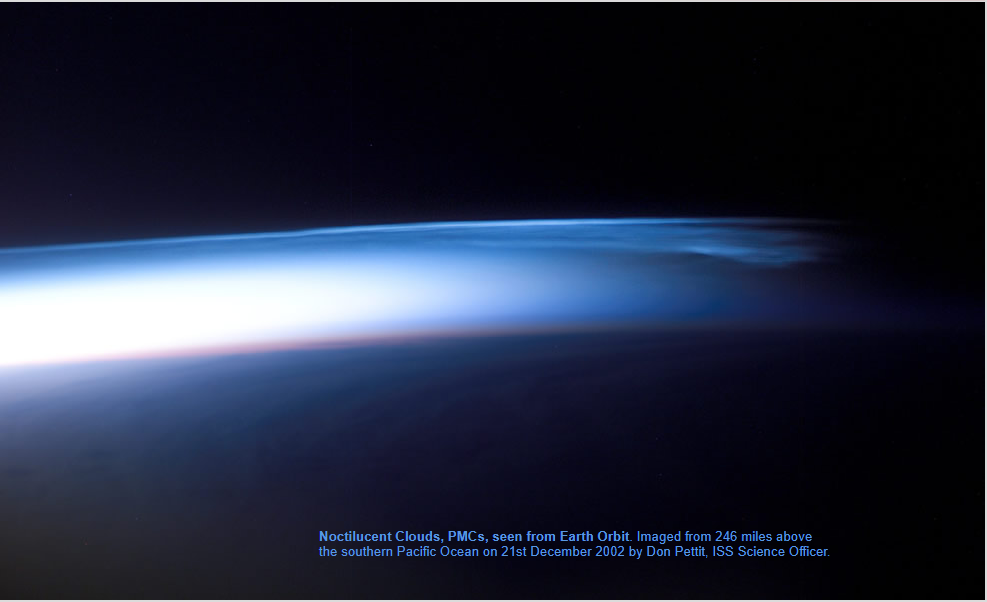Noctilucent Clouds from Earth Orbit
Noctilucent Clouds from Earth Orbit: A Spectacular Astronomical Phenomenon
Noctilucent clouds, also known as Polar Mesospheric Clouds (PMCs), are a mesmerizing astronomical phenomenon that can be observed from Earth's orbit. These ethereal clouds, which appear as glowing wisps against the darkness of the night sky, create a captivating spectacle for both astronauts and stargazers alike. In this article, we will delve into the intricacies of these elusive clouds, exploring their formation, characteristics, and the awe-inspiring experience of witnessing them from the vantage point of space.
Unveiling the Secrets of Noctilucent Clouds
Noctilucent clouds form in the mesosphere, the third layer of Earth's atmosphere, at an altitude of approximately 80 kilometers (50 miles) above the surface. They occur during the summer months in polar regions when conditions are just right. While the lower atmosphere experiences warmer temperatures during this time, the upper mesosphere remains incredibly cold. This extreme temperature contrast sets the stage for the formation of these remarkable clouds.
The Chemistry Behind the Glow
The unique luminosity of noctilucent clouds can be attributed to a combination of factors. Tiny ice crystals, measuring only a few micrometers in size, form the core structure of these clouds. These ice crystals are thought to originate from water vapor freezing onto meteoric dust particles. Additionally, the presence of high-altitude atmospheric gases, such as methane and nitric oxide, plays a crucial role in enhancing the cloud's brightness. Sunlight reflecting off these ice crystals results in the stunning display of noctilucent clouds.
A Delicate Dance of Light and Shadows
From Earth's orbit, astronauts are treated to a breathtaking spectacle as they witness noctilucent clouds shimmering in the darkness. As sunlight illuminates these high-altitude clouds, they appear to glow with an otherworldly radiance. The intricate patterns and delicate tendrils of the clouds create an ethereal dance of light and shadows against the backdrop of the vast cosmos. Captivated by this celestial ballet, astronauts often describe the experience as awe-inspiring and humbling, reminding them of the immense beauty and complexity of our planet.
A Window into Earth's Changing Climate
Beyond their visual splendor, noctilucent clouds also serve as a valuable indicator of Earth's changing climate. Scientists have observed a correlation between the occurrence of these clouds and the increase in greenhouse gases in the atmosphere. As greenhouse gases trap heat near the Earth's surface, the mesosphere cools, providing optimal conditions for the formation of noctilucent clouds. Monitoring the frequency and intensity of these clouds allows researchers to gain insights into the long-term effects of climate change and the impact on our planet's upper atmosphere.
Citizen Science and Noctilucent Cloud Research
In recent years, citizen scientists have played a vital role in advancing our understanding of noctilucent clouds. Through the power of photography and social media, individuals from around the world have contributed to documenting the occurrence and characteristics of these clouds. This collective effort has enabled scientists to gather a wealth of data and expand their knowledge about these elusive phenomena. By engaging with the public, researchers can better comprehend the global distribution and behavior of noctilucent clouds, furthering our comprehension of Earth's upper atmosphere dynamics.
Protecting the Fragile Beauty of Noctilucent Clouds
Despite their captivating allure, noctilucent clouds face potential threats from human activities. The release of certain chemicals into the atmosphere, such as chlorofluorocarbons (CFCs), can have detrimental effects on the ozone layer. Any depletion in the ozone layer could alter the temperature balance in the mesosphere, potentially impacting the formation and visibility of these unique clouds. Therefore, it is crucial to continue monitoring and mitigating human-induced factors that may disrupt the delicate equilibrium required for noctilucent cloud formation.
In conclusion, witnessing noctilucent clouds from Earth's orbit is a truly awe-inspiring experience. These ethereal formations, created by the interplay of ice crystals, atmospheric gases, and sunlight, provide a captivating display against the backdrop of the night sky. Not only do these clouds serve as a source of wonder and inspiration for astronauts, but they also offer valuable insights into Earth's changing climate. Through the collaborative efforts of scientists and citizen scientists alike, we can continue to unravel the mysteries of noctilucent clouds and appreciate the fragile beauty they represent in our ever-changing world.

Noctilucent Clouds, PMCs, seen from Earth Orbit. Imaged from 246 miles above the southern Pacific Ocean on 21st December 2002 by Don Pettit, ISS Science Officer.
Image courtesy of the Image Science & Analysis Laboratory, NASA Johnson Space Center.
Note: this article has been automatically converted from the old site and may not appear as intended. You can find the original article here.
Reference Atmospheric Optics
If you use any of the definitions, information, or data presented on Atmospheric Optics, please copy the link or reference below to properly credit us as the reference source. Thank you!
-
<a href="https://atoptics.co.uk/blog/noctilucent-clouds-from-earth-orbit/">Noctilucent Clouds from Earth Orbit</a>
-
"Noctilucent Clouds from Earth Orbit". Atmospheric Optics. Accessed on April 20, 2024. https://atoptics.co.uk/blog/noctilucent-clouds-from-earth-orbit/.
-
"Noctilucent Clouds from Earth Orbit". Atmospheric Optics, https://atoptics.co.uk/blog/noctilucent-clouds-from-earth-orbit/. Accessed 20 April, 2024
-
Noctilucent Clouds from Earth Orbit. Atmospheric Optics. Retrieved from https://atoptics.co.uk/blog/noctilucent-clouds-from-earth-orbit/.